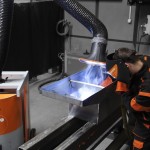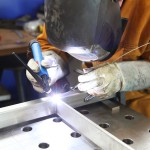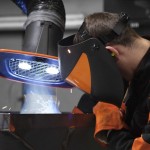Welding light metals: This must be noted
Aluminium, magnesium, titanium: These raw materials differ in many properties, but have one thing in common. They belong to the group of light metals. This includes metals whose unit volume weight does not exceed 5 g/cm3. The lightest of the light metals is lithium (0.534 g cm3), the heaviest is titanium (4.506 g cm3). The raw materials are processed using common methods such as TIG welding. Due to their plastic deformability and mechanical properties, however, some special features must be taken into account.
Light metal constructions are increasingly in demand, where aluminium and magnesium are the most commonly used light metals. This is because they help to protect the environment as well as to save energy. Light metals and their alloys are used in different sectors and technologies. For example, they are used in car manufacturing, medical engineering, nuclear power and the chemical industry. The various raw materials are suitable for different industries. However, different hazardous substances are released during processing.
In addition: The dusts released when grinding and polishing these materials react easily with the oxygen in the atmosphere. When stirred up, they can form an explosive dust/air mixture with the air in the room. Tested and approved dust extractors must be used for the extraction of dust that has not reacted. The fume particles are usually reacted out during welding work. Only the analysis of a dust sample provides certainty, however. This is not the case with grinding particles that usually only oxidise on the surface and therefore pose a greater risk of explosion. As a result, welding and grinding work must be strictly separated.
Light metals in use: Aluminium
A particularly widespread light metal is aluminium. The raw material is gaining in importance – especially from an economic perspective – because it is traded at a high price on the world market. But also the aspect of environmental friendliness is growing in importance from year to year: Aluminium is almost entirely recyclable and is therefore being used more and more often. The processing of the raw material is generally considered to be difficult because aluminium is a comparatively soft metal. This means that the workpiece deforms quickly. Compared to steel, however, aluminium is a light metal that convinces with its durability and weather resistance.
But even light aluminium material has its pitfalls – especially during processing. This is because the aluminium particles that evaporate during welding react with the oxygen in the air to form aluminium oxide when they cool down. If the particles are not properly extracted, they can endanger the health of welders. For example, the ingestion of aluminium oxide can pollute the respiratory tract. This can result in bronchitis or aluminosis, for example. In Germany, aluminosis is an occupational disease that is subject to compensation.
Light metals in use: Magnesium
Magnesium is the lightest utility metal and is used in aircraft and car manufacturing. Its low density makes it a raw material that is easy to cast and harden. Magnesium also scores points in terms of environmental friendliness: The metal has a recyclability of 100 percent. However, unlike other light metals, magnesium is susceptible to corrosion and is not easy to cold form. When the raw material is welded, this can produce magnesium hydroxide. Ingestion of the hazardous substance is slightly toxic, as it can provoke coughing and breathing difficulties. Contact with the eye area causes pain and redness. Also, users must never forget the easy flammability of the raw material. This is because magnesium components burn with an extremely bright flame. Looking directly into the flame can injure the eyes and should therefore be avoided. Another special feature of this light metal is that magnesium continues to burn even under water, splitting the water into oxygen and hydrogen. The hydrogen released in the process rises so ignitable gas mixtures form on the surface.
Light metals in use: Titanium
This comparatively heavy light metal is mined mainly in Scandinavia, Australia and America. Despite its very low density, titanium has high strength. In addition, as a raw material, it is not susceptible to corrosion. The high extraction costs, however, make titanium expensive. The processing of the metal is also complex and cost-intensive, so that objects and components made of titanium are very high priced.
The processing of titanium produces the pollutant titanium dioxide. This hazardous substance is associated with a high level of respiratory and pulmonary exposure. An overload of particles leads to chronic inflammation, also called chronic bronchitis. The consequences must not be underestimated: Chronic obstructive pulmonary disease often develops. Titanium and its compounds have no substance-specific limit value, so the general dust limit value applies for the assessment of exposure.
Light metals in use: Beryllium
The application of the light metal beryllium is primarily in the fields of aerospace and reactor technology as well as medical engineering. The TRGS 900 specifies a limit value of 0.00006 mg/m³ – an extremely low limit value. Thus, the processing of beryllium requires the use of certain procedures. This is because the light metal has a low density and particularly high rigidity. During processing, the hazardous substances beryllium oxide and beryllium salts occur. These are among the most toxic hazardous substances welders are exposed to. The consequences are many: These toxic substances attack various organs – from the skin to the lungs to the spleen and liver. If welders are exposed to hazardous substances, damage can occur to their health even many years later. For example, tumours form over a latency period of many years and are often only discovered too late.





